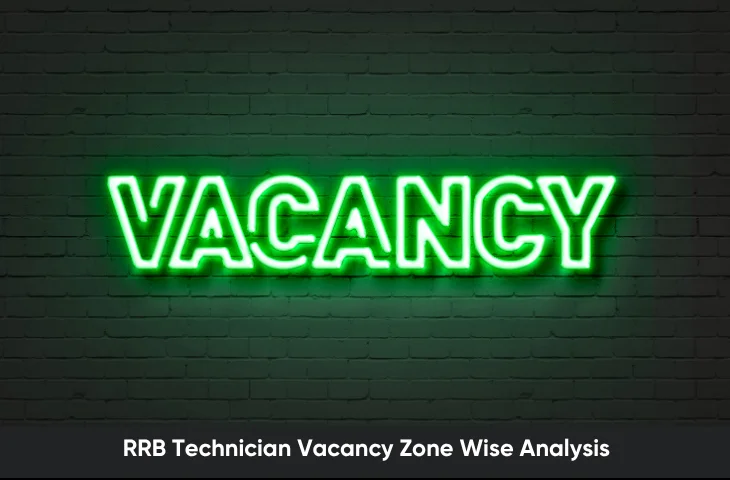RRB Technician Vacancy Zone Wise: A clear, zone-level view of Technician vacancies tells a richer story than national totals alone; it shows where railways are investing in capacity, where backlog posts exist, and which regions repeatedly open the most technical opportunities. This article walks through the patterns, explains how to read zone-wise tables, and offers a practical framework for analysing RRB Technician Vacancy Zone Wise data from recruitment notifications over the years.
Why “RRB Technician Vacancy Zone Wise” Matters for Recruitment?
The official authorities release the zone wise vacancies for recruitment in the RRB Technician Notification. That zone-level breakup is crucial because:
- It shows which Zonal Railways / Production Units have the highest operational need.
- It helps aspirants choose which RRB to apply to (options once given are final for many CENs).
- It exposes trends — e.g., some zones hire in big drives (workshops, production units), while others show steady backlog clearances.
You can find the zone-wise vacancy tables inside each CEN’s Annexure B (see technician CENs for examples).
High-level Past Totals for RRB Technician Vacancy
Below is a concise snapshot comparing two large, well-documented recruitment cycles so you get a sense of scale before drilling into zone patterns.
| Year | What it covered | Total Technician Vacancies |
| CEN-01/2018 (revised) | ALP & Technicians (revision published Sept 2018) | 36,576 (Technicians) — part of a revised total of 64,371 (ALP + Technicians). |
| CEN-02/2025 (Technician Categories) | Technician Grade-I (Signal) & Technician Grade-III categories | 6,055 (Grade-III) + 183 (Grade-I Signal) = 6,238 total. Annexure B contains the RRB/zone distribution. |
Typical Zone-Level Patterns Seen across CENs
When you inspect RRB Technician Vacancy Zone Wise tables across CENs, these common patterns emerge:
- Zones that host large workshops or production units (e.g., Central / Southern / Western zones with loco workshops, carriage works) often show larger technician vacancies in mechanical, electrical and fitter trades.
- Production units (ICF/CLW/DLW etc.) sometimes appear separately in Annexure B with their own allotments.
Backlog vs fresh requirement
- A portion of vacancies in many CENs are backlog (clearing existing sanctioned posts), while others are new/manpower expansion. Annexure notes or asterisks usually mark backlog posts in the vacancy table.
Trade skew across zones
- Some zones show heavy vacancies in certain trades (e.g., many “Fitter / Electrician / Welder” posts) depending on the zone’s maintenance profile. That affects local cut-offs and competition levels.
| Zone | 2018 Vacancies | 2025 Vacancies |
| Kolkata | 6,500 | 3,200 |
| Secunderabad | 9,000 | 4,000 |
| Mumbai | 7,000 | 3,200 |
| Prayagraj | 8,500 | 4,300 |
| Bhubaneswar | 6,200 | 3,500 |
| Bilaspur | 7,000 | 3,600 |
| Ranchi | 3,000 | 2,200 |
| Guwahati | 3,200 | 2,000 |
How to Do Your Own Railway Technician Vacancy Zone-wise Analysis?
If you want to analyse RRB Technician Vacancy Zone Wise data for a given CEN, use this practical method:
- Download the detailed CEN PDF and open Annexure B (RRB/Zone table). (Every CEN contains an Annexure B with the exact RRB/zone numbers.)
- Extract the fields: RRB name, Zonal Railway/PU, Trade/Post name, vacancy counts by category (UR/SC/ST/OBC/EWS) and total.
- Create a simple spreadsheet with columns: Year/CEN, RRB, Zone, Trade, Total vacancies. This lets you filter and pivot by zone or trade.
- Compare across CENs (e.g., 2018 vs 2025) to see increases/decreases per zone — compute percentage change to quantify trend.
- Look for signals: repeated high numbers for the same zone → strategic hiring; sudden drops → hiring freeze or redistribution; many backlog-marked posts → legacy demand.
- Factor reservation & PwBD breakdowns — these can affect effective seats for open competition and vary zone to zone.
Quick Illustrative Checklist for Aspirants Using Zone Data
A illustrative checklist for aspirants using RRB Technician Vacancy details zone wise are given below:
- Prefer applying to the RRB/zone with higher vacancies in your trade (more posts → slightly better odds).
- Remember RRB selection and options are binding for that notification; read the instructions carefully.
- Check if a zone shows many backlog vacancies — those may have different cut-off dynamics (sometimes lower, sometimes higher depending on local applicants).
- Use past CEN Annexure B tables to see which zones historically had more technician recruitment — this is a fair proxy for where future drives may reappear.
Key Points of RRB Technician Vacancy Zone Wise
We have given below certain points showing the importance of knowing RRB Technician Vacacny Zone Wise. Check out the details below:
- Zone-level tables (Annexure B) are part of every RRB Technician CEN and are the authoritative source for RRB Technician Vacancy Zone Wise counts.
- Large drives (like the revised 2018 CEN) can contain tens of thousands of Technician + ALP posts; more recent focused CENs (e.g., 2025) may show much smaller, targeted vacancy totals (6,238 in CEN-02/2025).
- Zone patterns reflect operational needs (workshops, production units) and backlog clearance; inspect trade-level splits to refine application strategy.
- Always download the Annexure B for the specific CEN you’re interested in — it’s the single, most important file for zone-wise planning.
A meaningful RRB Technician Vacancy Zone Wise analysis requires reading Annexure B of the CENs, mapping trade-level vacancies against zones, and comparing across recruitment cycles. For aspirants, that zone lens is practical, it helps pick the right RRB, manage expectations on cut-offs, and tailor strategy by trade and region. For researchers or coaching mentors, it’s the quickest way to spot where Indian Railways is expanding technical capacity and where backlog reduction is still ongoing.
FAQs
It refers to the distribution of technician vacancies across different Railway Recruitment Boards (RRBs) and their corresponding zones. Each recruitment notification (CEN) publishes a detailed breakdown in Annexure B, showing the number of posts available in each RRB zone.
Candidates can apply through only one RRB for a given CEN.
Zones with higher vacancies may offer slightly better chances of selection.
Zone-wise data helps candidates understand trade distribution, backlog positions, and long-term hiring patterns.
CEN-01/2018 (revised) announced a massive recruitment drive with 36,576 technician posts (part of 64,371 total).
CEN-02/2025 offered a smaller, targeted recruitment with 6,238 technician posts.
This indicates a decline in vacancy size, but with a greater focus on specific categories.
The official CEN PDF notification contains an Annexure B with the RRB/Zone-wise and trade-wise vacancy table. Candidates should always download the latest notification from the official RRB websites to avoid misinformation.
Yes. Zones with higher vacancies sometimes have relatively lower cut-offs, while zones with fewer vacancies may see higher cut-offs due to tougher competition. However, this also depends on the number of applicants and trade preferences in that zone.
- RRB Technician Study Plan for Working Professional, Know Details
- Top Reasoning Questions for RRB Technician, Download Free PDF
- Important General Science Questions for RRB Technician Exam
- RRB Technician Vacancy Zone Wise, Check Analysis Over Years
- RRB Technician Subject Wise Weightage, Know the Impact of PYP
- RRB Technician Exam Preparation Strategy 2025, Know Details

Hello! This is Arijit Dutta. I am a skilled Content Writer at Oliveboard with nearly 3+ years of experience in crafting engaging, informative, and exam-focused content for the Railways Domain. With a strong command of language and a keen understanding of learner needs, I contribute significantly to Oliveboard’s mission of delivering high-quality educational resources. Passionate about clear communication and continuous learning, I consistently create content that helps government job aspirants achieve their goals. Outside of work, I enjoy playing cricket and listening to music, which helps me stay balanced and creative in my professional journey.
